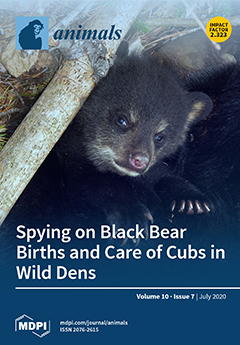As a result of public health concerns regarding antimicrobial resistance in animal-based food products, conventional poultry companies have turned to ‘raised without antibiotics’ (ABF) and organic farming systems. In this work, we evaluated the influence of rearing systems on antimicrobial susceptibility in
E. coli and extended-spectrum β-lactamase (ESLB)
E. coli diffusion in conventional (C), organic (O) and antibiotic free (ABF) chicken samples collected from cloacal swabs and skin samples in slaughterhouse. The
E. coli isolates from conventional (135), antibiotic-free (131) and organic (140) samples were submitted to the Kirby–Bauer method and ESBL
E. coli were analyzed by the microdilution test. Conventional samples showed the highest number of strains resistant to ampicillin (89.6%;
p < 0.01), cefotaxime (43.7%;
p < 0.01), nalidixic acid (57.8%;
p < 0.01), ciprofloxacin (44.4%;
p < 0.001), and trimethoprim/sulfamethoxazole (62.2%;
p < 0.01), with patterns of multi-resistance to three (35.1%) and to four antimicrobials (31.3%), whereas most of the
E. coli isolated from antibiotic-free and organic chicken samples revealed a co-resistance pattern (29.2% and 39%, respectively). The highest number of ESBL
E. coli was observed in conventional, in both cloacal and skin samples and the lowest in organic (
p < 0.001). Our results are consistent with the effect of conventional farming practices on
E. coli antimicrobial resistance and ESBL
E. coli number, due to the use of antimicrobials and close contact with litter for most of the production cycle.
Full article






